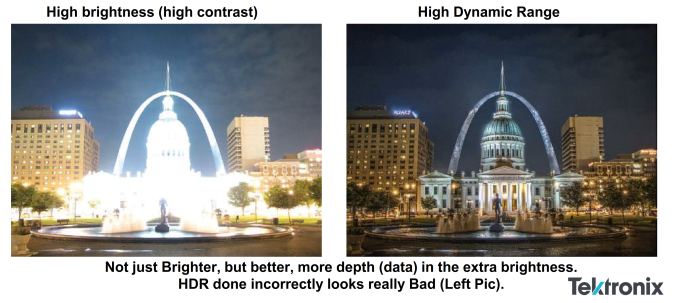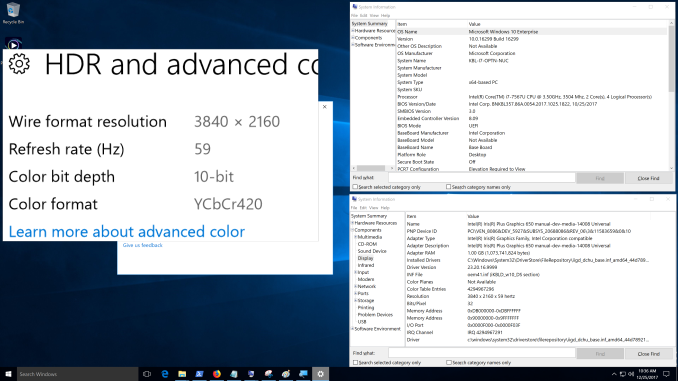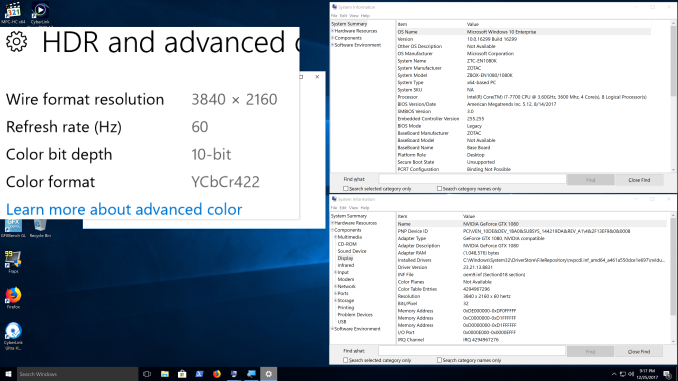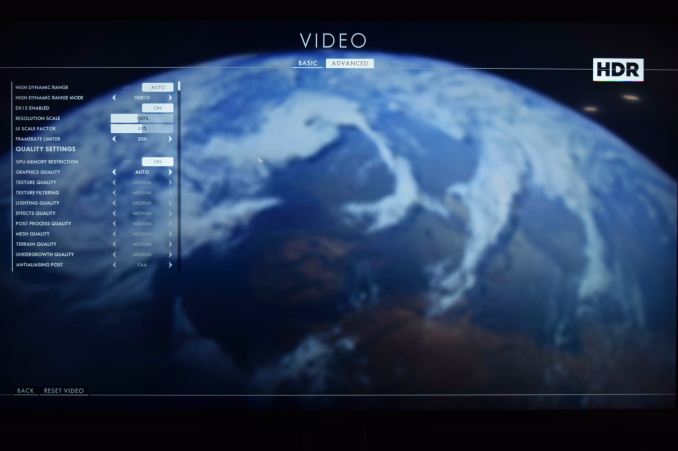A Budget Home Theater & PC Setup: 4K, HDR, UHD Blu-ray, and More
by Ganesh T S on December 26, 2017 8:30 AM ESTHDR Support
High Dynamic Range (HDR) is one of the most impressive features in the recent crop of 4K televisions. In layman's terms, it refers to the ability of a single frame to have wide variation in brightness for different regions. This allows the details in the dimly lit areas of the frame to be seen more clearly. Overall, it delivers a more vivid picture to the viewer. Note that this is quite different from the concept of high contrast.
Picture courtesy: SMPTE HDR Presentation from Steven Holmes of Tektronix
The ability of a display source to transmit HDR frames, as well as that of a display sink to be able to accept and understand them, can be gathered from the HDMI port's specifications. However, being able to accept and understand is only part of the problem. There are many low-cost 'fake HDR' TVs that simply parse the HDR information, but, do not have the ability to translate that to the display.
There are many HDR 'standards', with the base requirement being HDR10. Shifting a display sink into HDR mode involves the source sending some information (metadata) with the characteristics of the video being transported (the mapping of the pixel data to the displayed luminance, light levels in the video stream etc.). If this is static (i.e, done once when the shift to HDR mode occurs), it falls under the HDR10 category. Dolby Vision allows for the metadata to change on a frame-by-frame basis (dynamic). The upcoming HDR10+ standard will also support dynamic metadata. The takeaway is that Dolby Vision certification all but ensures a display with true HDR capabilities.
The TCL 55P607 comes with standard HDR10 and Dolby Vision support. The native Roku apps shift to the appropriate HDR mode based on the content being played back. We will analyze this more in the subsequent sections.
The NVIDIA SHIELD Android TV (SATV) is similar to the native Roku app in the TV with respect to treatment of HDR content. The main issue is that SATV doesn't support Dolby Vision yet, though there is a lot of clamor for it from SATV owners. Videos with HDR10 metadata shift the display to the appropriate HDR mode prior to playback.
PCs encounter additional challenges for HDR implementation. It is just not one company that is responsible for the feature. On one hand, the GPU driver vendors need to support it. On the other hand, the OS itself needs to provide hooks to enable HDR. Finally, the software ecosystem needs to catch up. The Windows 10 Fall Creators Update brought HDR10 capabilities for the Windows desktop into the stable ring. It also allowed streaming of HDR videos from YouTube and Netflix. Microsoft is continuing to fine-tune the HDR capabilities built into Windows 10.
Intel, along with CyberLink, had decided not to wait for Microsoft to deliver HDR on PCs. PowerDVD 17 was the first software Blu-ray player, and it only made sense for them to support HDR playback for applicable titles. The Intel / CyberLink solution for HDR when playing back certain Blu-rays in full-screen exclusive mode is orthogonal to Microsoft's HDR support.
The Windows 10 Fall Creators Update enabled desktop HDR and HDR video streaming on all the three test PCs described earlier.
HDR and Advanced Color Settings - Intel NUC7i7BNHX1 with Desktop HDR Enabled
The KBL-U platforms drove the display at YCbCr 4:2:0 10-bit, while the NVIDIA GTX 1080 drove the HDR output with higher quality (YCbCr 4:2:2 10-bit). For a good desktop experience, 4:4:4 is preferable.
HDR and Advanced Color Settings - Zotac ZBOX MAGNUS EN1080K with Desktop HDR Enabled
Gaming is not a focus in our HTPC reviews, but, we must give credit to NVIDIA for supporting Dolby Vision in their Pascal GPUs. Certain gaming titles such as Battlefield 1 support both HDR varieties (HDR10 and Dolby Vision), and the Zotac EN1080K is able to deliver it in a HTPC environment, thanks to its small form factor and relatively silent liquid cooling.
Battlefield 1 HDR Output from the Zotac EN1080K
Battlefield 1 Dolby Vision Output from the Zotac EN1080K
Unfortunately, Pascal's Dolby Vision support is available only in certain games, and is not applicable to streaming services like Netflix.
Microsoft's current approach to HDR with a desktop HDR mode is currently not efficiently implemented. For example, the desktop in the Zotac ZBOX MAGNUS EN1080K idles at 34.5W. With the HDR mode enabled, this jumps to 39.5W. In the KBL-U systems the penalty is of the order of 0.8W - 1W.















191 Comments
View All Comments
soper8 - Tuesday, December 26, 2017 - link
I would also agree that some AV forums have a more robust inventory of options but if sites like Anandtech others don't bring more into the fold of HTPC the community had less opportunity to grow.On the term "budget" used in the article: I think there some perspective on what could be spent on a HTPC setup vs the relative low cost of this setup.
My setup...
Server:
HP DL380 Gen 7 8 core 128gb ram
40TB+ RAID6 storage (72 TB raw)
Runs Windows 2012 R2 with Emby, Plex, Kodi backends
Provides iSCSI drive support for client recording
"TV" clients
1 Intel NUC 5ppyh
1 Zotac CI325
1 home built i5 4560T mini itx
1 home built i7 2600k atx
all have 8gb ram, 250ish SSD, Windows 7 or 8.1
last two have blue ray and amd discrete video
(I haven't jumped to 4k so I will have to swap out video cards on those two.)
Streamers
Microsoft wireless video adapters on all screens (supports windows, mac, and android)
TV tuners
Centon infinity 6 for cable card
HDHomerun Prime OTA
My point to basic/budget is all in the eye of the beholder and I haven't even listed tvs, amplifiers, tuners, etc.
we - Tuesday, December 26, 2017 - link
Retailers in the UK advertize the RRP of the Denon AVR-X2400H as £499, and it is easily obtainable at various retailers for £399, which is budget territory. How is it possible that the same product has a RRP of $999 in the US (according to the article)??we - Tuesday, December 26, 2017 - link
My mistake (ist a X3400H, not X2400H). Apologies.thestryker - Tuesday, December 26, 2017 - link
I do think that this article does fulfill the goal of explaining the current state of htpc and giving options. I'd like to think people are capable of reading the conclusion setting forth several option, but given a lot of the comments that doesn't seem to be the case.No matter how average the playback may be not mentioning the xbox one s/x as playback options is a missed opportunity as they're both cheaper than htpc for uhd blu-ray.
For many years I've had a pc connected to my tv for playback, but now I've switched to using the plex tv app on the tv and xbox one s for blu-ray playback. The draconian approach to drm drove me away from the htpc and I don't see that changing. Most good 4k tvs have netflix/amazon built in and many have hulu support. There's really not much to be gained by using a htpc anymore unless you have very specific needs.
darckhart - Tuesday, December 26, 2017 - link
I think this article was fine; it provides a starting point. HTPC crowd is far too opinionated to ever have consensus on "budget" and certain requirements (whether video or audio) preclude "budget." To do a comprehensive selection and review would be ridiculous. This article was, if you have a TV that supports X, and you want audio that supports Y, and you want to have a PC in there, here's a rough setup and the limits of it.That being said, this article convinced me that the htpc space for video is definitely not "it just works" and it seems like they're making it difficult because no one cares to play well with each other. This leaves the consumer having to juggle every piece of equipment and make sure they're updated for this or that.
Golgatha777 - Tuesday, December 26, 2017 - link
Even dedicated AV equipment is getting really bad as of late. Does it support Dolby Atmos and Vision, is it HDCP 2.2 compliant, what about when HDMI 2.1 comes around, does it support all HDR standards, will it have a firmware update for any of the aforementioned and at what date, etc.?Kevin G - Wednesday, December 27, 2017 - link
The HTCP market is in a bit of shock as 'standards' have been rather fluid of late, something you never want a true standard to be.HDMI and HDCP are the two big factors as to why things have been so dynamic. The transition from HDMI 1.4 to HDMI 2.0 went rather well from a high level stand point and everything nowadays has going to pure HDMI 2.0 (there are still a few pieces of electronics that mix HDMI 2.0 and HDMI 1.4 ports). The complicating factor is that HDCP versions haven't been tied down to HDMI versions. So a HDMI 1.4 port could support HDCP 1.4 or HDCP 2.0. Similarly HDMI 2.0 can have either HDCP 2.0 or HDCP 2.2 support. Right now the coming HDMI 2.1 equipment is based around HDCP 2.2 but I fathom there will soon be a new version of HDCP announced for 8K content making the first wave of HDMI 2.1 gear useless outside of a glorified PC displays.
On the PC side of things, that requires OS updates to support the new versions of copy protections and hardware to enable it too. There appears to be active disdain by media companies to actually permit 4K disc playback on PC's, hence why it has such a long chain of requirements.
Reflex - Tuesday, December 26, 2017 - link
Ganesh -There is literally no way you could have wrote this that would have satisfied even half the home theater crowd. That entire space is full of opinions. I didn't really agree with your decisions either, but I don't have to because you aren't really telling anyone what to buy, you are documenting what you built and providing it for others who may wish to have a good starting point. And that is all you needed to do.
My own setup was recently rebuilt. I finally ditched the receiver concept and went with a soundbar.
LG OLED65B7A: $2049 via Amazon as a certified refurb (Beach Camera is reboxing non-refurbs to avoid the MSRP)
Samsung HW-K950 Sound Bar (open box special from an Amazon reseller, $760)
Awake Lion 5 port HDMI2/HDCP2.2 switch ($50)
Connected to that I have a FireTV, Xbox One S, a SteamLink (wish they'd do a 4k version) and a few older devices as well. It all works, including HDR and Dolby Atmos from devices that support it. By watching for open box or refurb marked items I saved around a grand from the price and this should last me for a long time. I do not miss the receiver, the sound bar I chose is the top rated in the space and has actual back channels and separate sub, it is fantastic with Atmos content. Plus my wiring is much simpler.
TV: https://www.amazon.com/dp/B074QQZ9VJ
Soundbar: https://www.amazon.com/dp/B01I0HW12O
HDMI Switch: https://www.amazon.com/dp/B06WV5YJ6H
Legacy device Switch: https://www.amazon.com/gp/product/B072F6XJHL
Network Switch: https://www.amazon.com/gp/product/B01AX8XHRQ
Total devices connected -
Xbox One S
Xbox 360
Xbox
Amazon FireTV2
SteamLink (connected to a gaming PC somewhere where I don't have to hear it)
Dreamcast
Golgatha777 - Tuesday, December 26, 2017 - link
For my own setup:$200 - XBox One S - Use it for all optical media and streaming. Supports HDR10, bitstream output of Dolby Atmos, and HDMI 2.0 for 4k@60Hz. It handles all my optical disc and Internet streaming needs.
$1000 (video card is $500 of it) - HTPC - has a GTX 1080, i7 3770k from an old build, and 16GB DDR3 memory. Plays back media files and ISO rips from a home server very nicely with 7.1 surround sound support built into the OS. I call this good enough for the convenience factor because setting up Dolby Atmos has proven to be a nightmare on Windows 10 so far.
$1200 - My receiver is a Yamaha RXA-3060 9.2 channel hooked up in a 7.1.2 configuration with HDCP 2.2 and HDMI 2.0a on all ports. It also supports HDR10 and BT.2020 out of the box. For the money, I figure this is about as future proofed as I can get on a receiver. I can also turn the last dot 2 (7.1.(2)) into a 7.1 and stereo set of speakers for a 2nd zone on the back, outdoor patio.
$1400 - LG 55EG9100 1080p TV - I'll worry about 4k discs once the powers that be sort out the standards for HDR, or all TVs start supporting both HDR10 and Dolby Vision (and the XBox One S gets Dolby Vision support); until then, so sale. For now, I'll buy a handful of 4k Bluray discs since I know I'll upgrade at some point, and I can enjoy the Dolby Atmos soundtracks now.
fallaha56 - Tuesday, December 26, 2017 - link
Sorry but very poor advice here(!)A good AV receiver lasts more than 4(!) years and here you are recommending someone buy one just as it becomes obsolete
HDMI 2.1 is future-proof for years, 2.0 is about to flop with HDR
Did you also say that Denon were sponsoring this article?!?